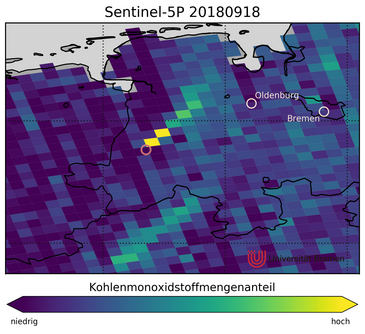In recent days, thanks to the highly accurate data from the Sentinel-5P environmental satellite launched in fall 2017, the scientists at the IUP have been able to determine the chemical composition of the exhaust gas plume from the moorland fire near Meppen. Significantly higher carbon monoxide and slightly higher nitrogen dioxide concentrations were detected compared to the background concentration. “Although the increased carbon monoxide concentrations were clearly visible from space, legal limits were very probably not exceeded in areas not directly adjacent to the moorland fires,” says Dr. Heinrich Bovensmann of the IUP.
Environmental Satellite Provides Detailed Data
The data on the chemical composition of the plume was collected by the Sentinel-5P satellite. The environmental satellite, which has only been in orbit for almost a year, flies around the Earth 14 times a day. It provides worldwide data on the composition of the Earth’s atmosphere with a spatial resolution of 3.5 to 7 kilometers. The evaluation and analysis of the data is carried out at the Institute of Environmental Physics (Director: Professor John P. Burrows) of the University of Bremen, which has built up a great deal of expertise in this field of research over 20 years. Sentinel-5P is based on technical concepts developed during the SCIAMACHY mission conducted under Bremen management.
Results of Sentinel-5P will also be presented at the International Astronautical Congress (IAC) in Bremen at the beginning of October.
For Your Understanding:
Carbon monoxide (CO) is a colorless, odorless, tasteless, and toxic gas (keyword “smoke inhalation”). It occurs, among other times, during the incomplete combustion of carbon-containing substances with insufficient oxygen supply, as is typical for moorland fires. (Source: Wikipedia)
Nitrogen dioxide (NO2) is a reddish-brown, poisonous, pungent gas with an odor similar to chlorine. It is produced during the combustion of fossil fuels such as gas, coal, and oil and is therefore a component of exhaust gases from motor vehicles and aircraft, oil and gas boilers, and gas- and coal-fired power plants, among other things. Nitrogen dioxide is also produced in forest fires and – to a lesser extent – in moorland fires. (Source: Wikipedia)
Additional Information:
IUP: www.iup.uni-bremen.de/deu/
Copernicus Sentinel-5P: www.esa.int/Our_Activities/Observing_the_Earth/Copernicus/Sentinel-5P/Introducing_Sentinel-5P
www.uni-bremen.de
FOR EDITORIAL OFFICES: Illustrative material for this press release is available for download at this address: seafile.zfn.uni-bremen.de/f/b8ed113d25704b1daa98/
Contact:
Dr. Heinrich Bovensmann
Institute of Environmental Physics, University of Bremen
Tel.: +49 421 218-62102
E-mail: heinrich.bovensmann@uni-bremen.de

